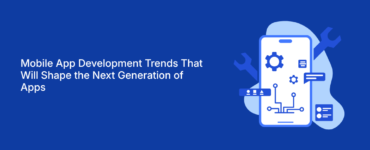The world of entertainment has transformed rapidly over the last decade, with streaming giants like Netflix, Amazon Prime Video, and Disney+ reshaping how people consume content. Today, more than 65% of the global population uses OTT services, and the number of users is projected to rise from nearly 5 billion in 2023 to over 6 billion by 2029. OTT platforms now account for around 70% of global TV viewing hours, firmly surpassing traditional broadcasting. Economically, the market is valued at over USD 340 billion in 2025 and is expected to grow to nearly USD 600 billion by 2030. With this massive growth, OTT App Development has become a key strategy for startups and established media companies alike to reach wider audiences. In this article, we’ll walk you through how to develop an OTT app platform, the key features to prioritize, estimated costs, and the best technologies to build a scalable and competitive solution.
What is OTT App Development?
OTT stands for “Over-The-Top,” which simply means delivering content via the internet without relying on traditional broadcasting or cable operators. An OTT platform gives users access to video or audio content through mobile apps, web platforms, and smart TVs. Think of services like Netflix, Hulu, or Disney+ — but OTT isn’t limited to entertainment alone. Fitness apps offering workout videos, e-learning apps providing courses, and sports platforms live-streaming matches are all examples of OTT platforms.
OTT app development involves building the technology infrastructure that powers this experience. It’s not just about designing an app but also ensuring seamless video delivery, secure payment options, personalized recommendations, and multi-device accessibility.
How to Develop an OTT App Platform
Developing a successful OTT platform is a journey that combines technology with strategy. Here’s how the process typically unfolds:
1. Start with Market Research and Audience Understanding
Before writing a single line of code, it’s essential to know who you’re building for. Are you targeting entertainment lovers, sports fans, learners, or fitness enthusiasts? Understanding audience behavior — what they watch, how long they stay engaged, and what devices they prefer, helps shape your app’s design and features.
2. Build a Strong Content Strategy
Content is the backbone of every OTT app. A startup might begin with niche content — for example, a platform dedicated to indie films, regional shows, or specialized educational material. A well-defined content strategy ensures you stand out instead of getting lost among big players like Netflix.
3. Design Features That Matter
A great OTT app is more than just a video library. It should make the user’s journey smooth and enjoyable. Core features usually include:
- User-friendly navigation so content is easy to find.
- Smart recommendations powered by AI to keep viewers engaged.
- Multiple payment options like subscriptions, ads, or one-time purchases.
- Cross-device support so users can switch from phone to TV without interruption.
- Offline downloads for convenience.
Each feature should serve the user while also helping your business model grow.
4. Choose the Right Technology Stack
When it comes to performance and scalability, technology choices make all the difference. Some of the best technologies for OTT app development include:
- Front-end frameworks like React Native or Flutter to build responsive mobile apps.
- Backend platforms such as Node.js or Django to handle data, streaming, and user management.
- Cloud services like AWS or Google Cloud to ensure uninterrupted video delivery.
- CDN (Content Delivery Network) providers such as Cloudflare or Akamai to minimize buffering across regions.
- Video processing tools like FFmpeg or Wowza for encoding and streaming.
Picking the right stack ensures your platform runs smoothly even with thousands of simultaneous users.
5. Testing, Security, and Launch
Security is critical in OTT app development. From protecting user data to securing video content with DRM (Digital Rights Management), no compromises can be made. Once features and security are in place, rigorous testing across devices ensures a seamless user experience. The final step is launching on multiple platforms — iOS, Android, Smart TVs, and web, to maximize reach.
OTT App Development Cost and Features
The cost of building an OTT app depends on various factors, including design complexity, feature set, and target devices. A simple MVP (Minimum Viable Product) may start at around $25,000–$40,000, while a fully customized, enterprise-level platform can easily exceed $100,000.
Some of the biggest cost drivers include:
- Number of platforms (just mobile, or also web and smart TV).
- Streaming quality (supporting 4K requires stronger infrastructure).
- Personalization and recommendation systems, which often rely on AI.
- Payment integration for global markets.
- Content management dashboards for admins.
For startups, it’s often best to launch with essential features and expand gradually based on user feedback.
Best Technologies for OTT App Development
Choosing the right technologies is what separates a laggy, frustrating app from a smooth, engaging platform. Some popular tools include:
- React Native or Flutter for cost-effective, cross-platform mobile app development.
- React.js for building intuitive web interfaces.
- Node.js for scalable backend solutions that can handle thousands of concurrent streams.
- Cloud storage and CDN integration for delivering videos worldwide without buffering.
- Analytics platforms to track viewer behavior and refine content strategy.
OTT Platform Development Guide for Startups
For startups, entering the OTT market might feel overwhelming, but the key is to start small and grow strategically. Instead of competing head-on with global giants, focus on a specific niche where you can add value. For example, a fitness trainer could launch a workout streaming app, or a language coach could create an e-learning OTT platform.
Here’s a practical approach:
- Begin with an MVP to test your idea with a smaller audience.
- Use affordable cloud-based services instead of building expensive infrastructure from scratch.
- Invest in good UI/UX so your app feels professional, even if it has fewer features.
- Continuously analyze viewer feedback and improve content offerings.
By gradually expanding, startups can avoid high upfront costs while steadily building a loyal audience.
Conclusion
The rise of streaming has opened new opportunities for businesses of all sizes. Whether you’re a startup aiming to reach niche audiences or an established brand looking to strengthen your digital presence, OTT app development can help you build a sustainable and profitable platform.
Understanding how to develop an OTT app platform, estimating OTT app development cost and features, and leveraging the best technologies for OTT app development will give you a strong foundation. For startups, this guide can serve as a roadmap to navigate the competitive OTT landscape and carve out your own success story.
FAQs on OTT App Development
1. What is OTT app development?
OTT app development is the process of creating streaming applications that deliver video or audio content over the internet, bypassing traditional cable or satellite TV. These apps allow users to watch movies, TV shows, live events, or even educational content on devices like smartphones, smart TVs, and web browsers.
2. How much does OTT app development cost?
The cost of OTT app development varies depending on features, design complexity, and target devices. A basic MVP may cost between $25,000–$40,000, while a feature-rich, multi-device platform with advanced security and AI-driven recommendations can exceed $100,000.
3. What are the essential features of an OTT app platform?
Some must-have features in OTT app development include user registration, secure payment options, adaptive video streaming, content recommendations, offline downloads, and an admin dashboard for content and user management.
4. Which are the best technologies for OTT app development?
The best technologies for OTT app development often include React Native or Flutter for mobile apps, React.js for web platforms, Node.js or Django for backends, and cloud/CDN solutions like AWS, Google Cloud, or Akamai for smooth video delivery.
5. How do startups benefit from OTT app development?
OTT app development offers startups an affordable way to reach niche audiences with targeted content. By starting with a Minimum Viable Product (MVP) and using cloud-based solutions, startups can reduce costs, test their idea, and grow gradually into a scalable platform.
6. How long does it take to develop an OTT app platform?
The development timeline for an OTT app platform depends on complexity. A simple MVP might take 3–4 months, while a fully customized OTT app with multi-device compatibility and advanced features can take 6–12 months.




